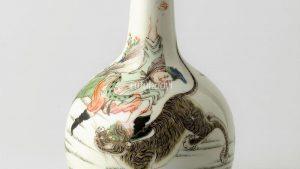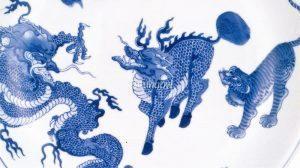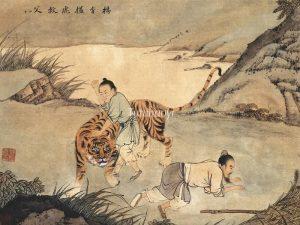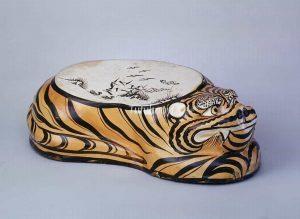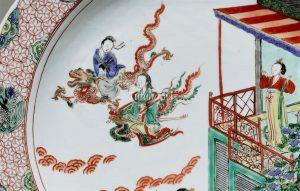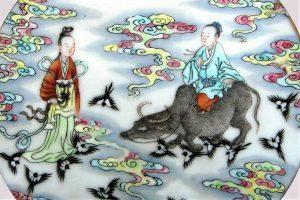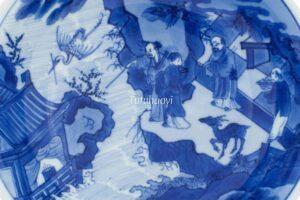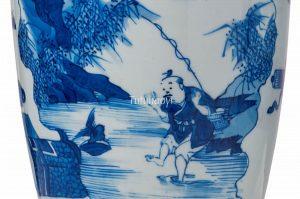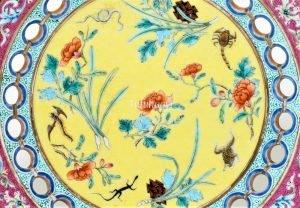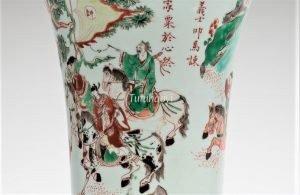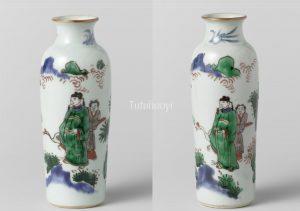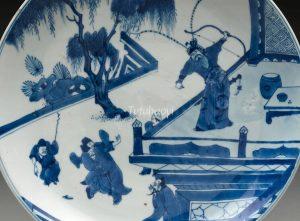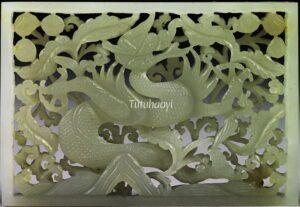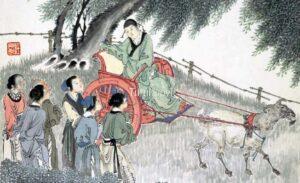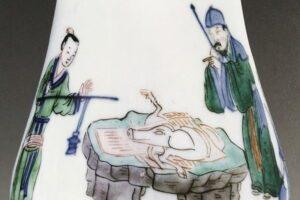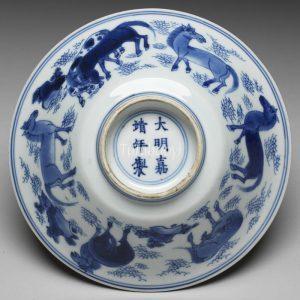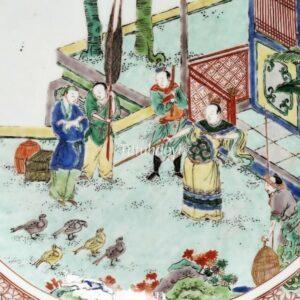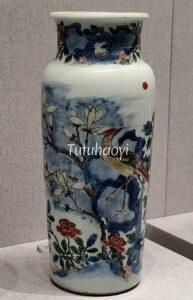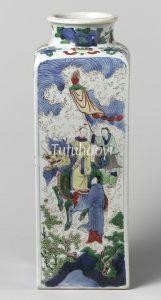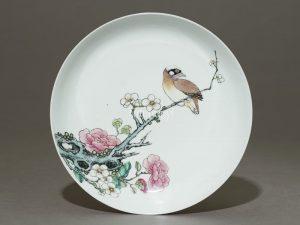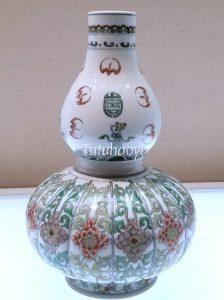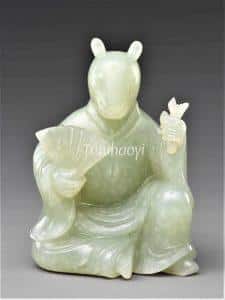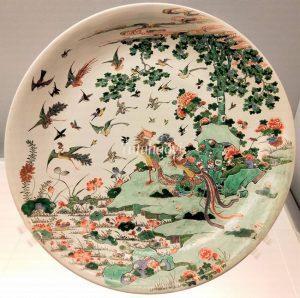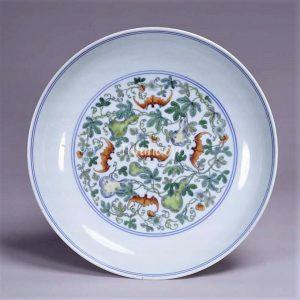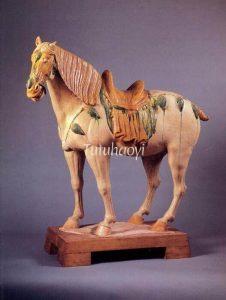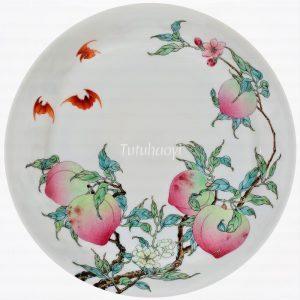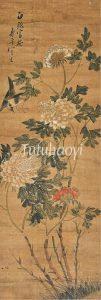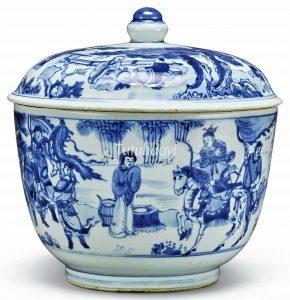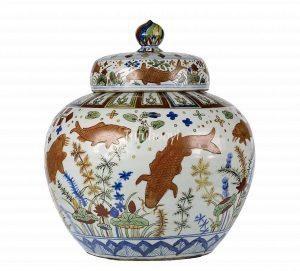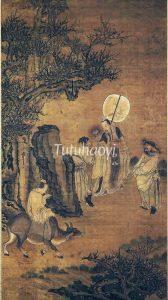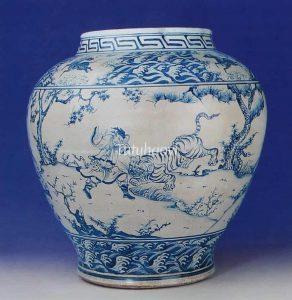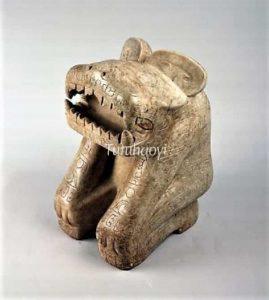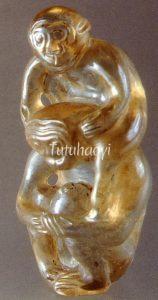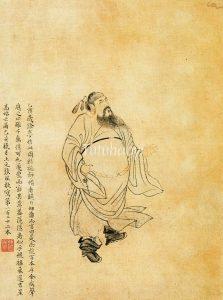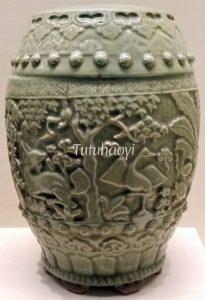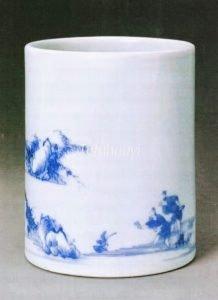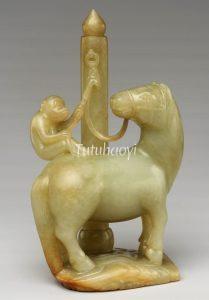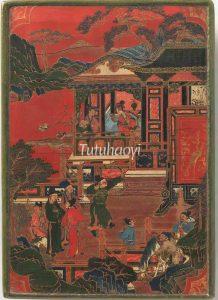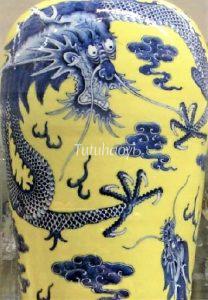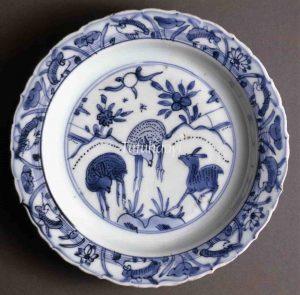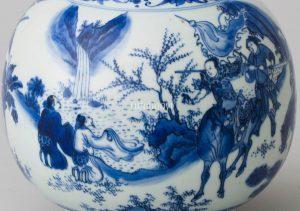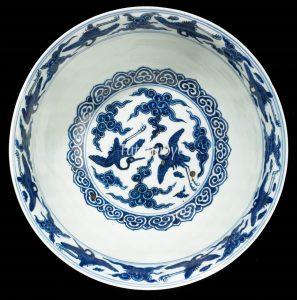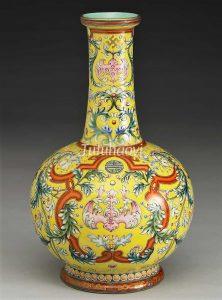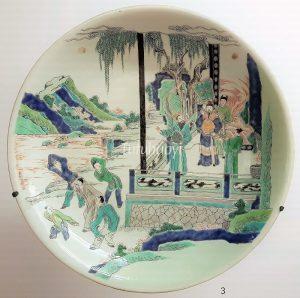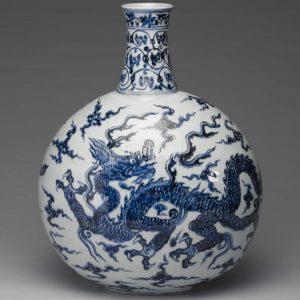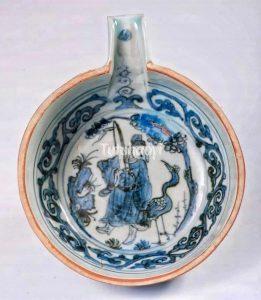Showing Results Containing
The Chinese Valentine’s Day, Qixi Festival (七夕节), is just around the corner. It falls on the seventh day of the seventh month of the traditional Chinese year. Dr Yibin Ni has conducted comprehensive research on this topic and has written an articl...
‘Wu Song slaying the tiger’ is a popular fictional story among Chinese people. But it’s hardly noticed that this story scene has been chosen in Chinoiserie decorative art in Europe. Here is Dr Yibin Ni’s interesting research and his unique insight...
Dragon and phoenix are commonly seen motifs in Chinese visual culture. Tiger, qilin and tortoise, at the same time, are favoured creatures symbolic for auspice. But when the motifs of the above five beasts are combined together, they have more mea...
‘Yang Xiang trying to throttle the tiger to rescue her father’ is a well-known story passed down from generation to generation in ancient China. However, Yang Xiang has sometimes been portrayed as a male figure on traditional Chinese artworks. Let...
2022 is the year of Tiger according to Chinese lunar calendar. Dr Yibin Ni has conducted a research overview of the pictorial representation of the tiger in the background of Chinese culture and history, from the origin of its motif in relics to v...
Chinese people deeply respect the elderly and traditionally consider a long existence to be one of the most important blessings in a person’s life. Here are many examples of how artists have combined a variety of longevity symbols to reinforce the...
Appreciation of a top-tier porcelain garlic-head bottle vase painted with a pair of red-whiskered bulbuls in polychrome enamels over transparent glaze in the falangcai style and gilding displayed in the Petite Galerie of the Louvre in Paris.
Correctly identifying figures is crucial to deciphering an obscure story scene. Looking at this featured image, for example, some may think that the two figures in non-specific attires on a dragon and a phoenix are anonymous Daoist immortals. But ...
On the seventh day of the seventh month of the lunar Chinese year, young men and women will celebrate their traditional ‘Valentine’s Day’, Qixi Festival (七夕节). The custom can be traced back to an ancient story.
More often than not, traditional Chinese motifs or symbols are not receiving their deserved attention, being given simplistic or inadequate labels and inaccurate explanations in our museums, catalogues, or even scholarly writing. The treatment of ...
People who are not familiar with Chinese history and parables may have the impression that the above image is a genre painting of fisherman’s daily life. But in fact, there is more meaning to it. Dr Yibin Ni will explain the story in detail and ho...
On Duanwu Festival, Chinese people have a variety of practices, such as drinking rice wine sprayed with realgar powder and hanging images of the Heavenly Master on the lintel. Where did this tradition come from and how were these practices depicte...
The following article is a discussion of the substitution of a mythical beast for a horse as Grand Duke Jiang’s mount on three classic porcelain vases adorned with the same story scene of ‘Bo Yi and Shu Qi Trying to Stop the Mighty Zhou Army’. It ...
Through analysing a famous theme that depicts Bo Yi and Shu Qi Stopping the Zhou Army, Dr Yibin Ni has compared a number of porcelain vessels from Ming and Qing dynasties, and demonstrated his unique insight which can facilitate the correct dating...
When you mistake a motif in a traditional Chinese picture, you could have misinterpreted the meaning of the whole image intended by the ancient craftsman. Dr Yibin Ni has used the following example to illustrate the hidden meaning of a series of i...
Have you ever been puzzled by the description of ‘figural paintings’ for Chinese porcelains listed by various museums and auction catalogues? In fact, many Chinese paintings with figures refer to ancient stories and have meanings behind the scenes...
Story scenes painted on Chinese porcelains are sometimes mysterious and challenging to understand. Dr Yibin Ni, whose specialised research is to demystify figures and story scenes, and decode motifs, symbols and pun rebuses in Chinese art, is here...
What is the value of deciphering pictorial scenes on traditional Chinese artworks? What is the importance in identifying correct figures and story scenes on antiques? Here is the editor’s conversation with Dr Yibin Ni, an internationally ren...
The story of the statesman Bing Ji (丙吉) inquiring about a panting buffalo in ancient China has been illustrated in various forms in traditional Chinese art. It is meant to praise high-ranking officials who can prioritise their duties for their cou...
Do you wonder why there is a goat drawing a carriage, rather than a horse, on traditional Chinese art pictures? Why are there so many people watching someone in a chariot? What is the story behind it? Here is what Dr Yibin Ni has to tell you.
The traditional theme of ‘Chen Ping Dividing Meat’(陈平分肉) is often mistakenly referred to as Chen ‘Selling Meat’ or even ‘Picture of Selling Meat’ in Chinese art reference books, which reduces a historically significant theme to a mere genre painti...
Ancient Chinese rulers used elephants in battle, and the animal has long been a symbol of strength, prudence, and wisdom. The Chinese character for elephant, 象 (xiàng), is a homophone of 祥 (xiáng), meaning ‘auspicious’ or ‘lucky’. As a result, elephants frequently appear in Continue Reading
The ‘Eight Horses’ (Ba Jun Tu 八骏图) is a classic motif in Chinese art, especially prominent in ancient paintings. Its origins are closely tied to the legendary journeys of King Mu of the Zhou Dynasty (周穆王), who reigned around the 10th century BCE. According to The Tale of King Mu (Mu Tianzi Zhuan 穆天子传), ...
The true name of Guiguzi (鬼谷子) remains unknown due to insufficient historical records, although some suggest the name ‘Wang Yi’. Legend has it that Guiguzi was a figure from the Warring States period (475–221 BCE), renowned as both a recluse and a political thinker, strategist, and Daoist. He is considered the founder of...
Jia Chang (贾昌 712–810) from the Tang Dynasty was renowned for his exceptional skills in training roosters for cockfighting. His legendary story is recorded in the Extensive Records of the Ta...
This is a legendary story about the birth of Confucius (551 BCE – 479 BCE), the renowned philosopher from ancient China during the Spring and Autumn Period (770 BCE – 475 BCE).
According to The Family History of Confucius (孔子家语), Confucius’ father, Shuliang He (叔梁纥), had nine daughters but no sons from hi...
Pun Design :
Three + Goat
Punning Details:
– In an ancient Chinese literature, The Book of Change (I-Ching 易经) that can be traced back to Western Zhou (1046–771 BCE), there are sixty-four different hexagrams (gua
‘Fu Gui Bai Tou 富贵白头’ is interchangeable with ‘Bai Tou Fu Gui 白头富贵’, with the same meaning of ‘May you enjoy wealth and high position ...
In an ancient Chinese book, The Huainanzi (淮南子 The Discourses of the Huainan Masters), compiled around 139 BCE, there was a legendary story about a fairy lady, Continue Reading
Phoenix has been deemed as a holy, noble and beautiful bird in the Chinese folk myths and was regarded as the king of all birds.
In Volume 915 of the comprehensi...
Deer were reputed to live for a very long time and hence, like Continue Reading
No animal has exercised as much influence over the destiny of China as the horse, which was central to the power of the various mounted nomadic peoples who dominated north China during the Period of Disunion (220–581CE), and the entire empire under the Mongols (Yuan dynasty, 1271–1368) and Manchus (Qing dynasty, 1644–191...
Pun Design:
Chinese bulbul + Peony
Punning Details:
– ‘bai tou 白头 white-headed’, of ‘bai tou weng 白头...
Pun Design:
Chinese bulbul + Two
Punning Details:
A pair of Chinese bulbuls in image imply the couple or the marriage;
‘bai tou 白头 white-headed’, of ‘bai tou weng 白头翁 Chinese bulbul’ (the white-headed-old-chap bird) can imply a ripe old age.<...
This scene was from a popular play ‘The Story of the White Hare’ (Bai Tu Ji 白兔记) and was much admired during the Ming dynasty.
Liu Zhiyuan 刘知远, the hero of the play set during the turbulent Five Dynasties (907–960), became an orphan when he was a teenager. His affluent neighbour looked after him and later...
Fish (鱼 yu) puns with the word yu 余 meaning ‘abundance’, therefore it symbolises wealth and prosperity. Continue Reading
‘Li Mi (李密 582–619) Hanging His Books on His Ox Horns’ is one of the inspirational self-improvement stories in ancient China. It was adopted in the famous Three-Character Classic (三字经 San Zi Jing), written in the 13th century. The primer served as children’s first textbook in elementary...
Nicknamed xingzhe (行者), ‘Pilgrim’ or ‘Traveller’, Wu Song (武松) is a popular fictional figure well-known for his slaying a tiger single-handedly after he was into...
The tiger has impressed the Chinese for being ferocious, valiant, and awesome. Numerous imaginations, legends, and images have been stimulated by the fascinating impact of this majestic beast on the nation’s psyche ever since antiquity.
Shuowen jiezi (说文解字), or Explanations of Simple Graphs and Analys...
Early in Jin dynasty (晋 265–420), Yang Feng 杨丰 and his teenage daughter, Yang Xiang 杨香, were harvesting the millet crops in the fields when he was attacked by a tiger. Th...
Pun Design:
Carrying on the Back + Monkey
Punning Details:
– ‘bei 背’ for ‘carrying on the back’ makes a pun on ‘bei 辈’ for ‘generation’
– ‘hou 猴’ from ‘hou zi 猴子’ for ‘monkey’ puns on ‘hou 侯’ for ‘marqui...
Wang Xizhi (王羲之, 303–361) is often said to be the greatest calligrapher in Chinese history. He has his biography in the official history of Jin 晋 dynasty (c. 265–420). One anecdote in it concerns his fame for his calligraphic skill and his love of geese. A Daoist priest in the neighbourhood raised a handsome flock of gee...
The flying mammal bat is called bian fu (蝙蝠) in Chinese. Image of the bat including its various stylised forms are often used in Chinese art to express an auspicious meaning, as ‘蝠 fu
The character 龟 gui for ‘tortoise’ is explained in volume 13 of the annotated version of the oldest dictionary in China, Shuowen jiezi 说文解字注 (Explanations of Simple Graphs and Analyses of Composite Graphs). There is a quote from Liu Xiang (刘向, 77 BCE – 6 BCE), the Han-dynasty imperial librarian, i...
Yang Shen (杨慎, 1488–1559), alias Sheng’an (升庵), is a literatus and poet in the Ming dynasty (1368–1644). He recorded in Volume Ninety-Four of Sheng’an Additional Works a folklore anecdote: ‘In the northern dialect, there is no difference in sound between the he 合 for “coming together” and the he 鹤 for “...
Duke Mu of the Qin State (秦穆公, died 621 BCE) was one of the so-called Five Hegemons (五霸 wuba) in the Spring and Autumn Period (770 – 476 BCE) (春秋 chunqiu). He had a daughter named ‘Nongyu (弄玉, meaning Playing Jade)’, who was a talented musician excelling at playing the sheng (笙 mouthorgan...
In this scene, there are several Chinese longevity symbols such as the
The story scene refers to an old Chinese saying: in the fight between the sandpiper and the clam, the fisherman has the best of it. This parable came from an ancient Chinese text entitled ‘Strategies of the Warring States (战国策 Zhanguo Ce)’. The book contains anecdotes of diplomacy and warfare during the Warring ...
The seventh day of the seventh month of the traditional Chinese year is the Chinese ‘Valentine’s Day’, Qixi Festival (七夕节). The custom can be traced back to an ancient story about a weaver girl and a cowherd:
Once upon a time, one of the daughters of the Lord of the Heaven lived on the east side of the Mi...
When Prefect Mao Bao 毛宝 was stationed in the city of Wuchang 武昌, Hebei province, during the Jin dynasty (晋 265-420), there was a story about a white tortoise who repay...
The Chinese character for ‘monkey’ is 猴 hou and it puns on the word for ‘marquis’ in Chinese 侯 hou. The expression ‘mashang 马上’ in Chinese is ambiguous in that it can mean, literally, ‘on a/the horse’, or it can mean, idiomatically, ‘right away’. Therefore, an image of a monkey on the back of a...
Li Yuan (李渊 566–635 CE) excelled at horse-riding, archery, and calligraphy as a young man. He was to be the future founder (reigned 618–626 CE) of the Tang dynasty (618–907 CE). Miss Dou was exceptionally smart and her father Dou Yi 窦毅, the governor of Dingzhou, was very particular about the quality of his future son-in-...
Father’s Day was set up to honour fatherhood and secure paternal bonds. One very potent motif in the repertoire of traditional Chinese pictorial culture in this regard is the image of a magnificent brawny Continue Reading
The earliest pictograph of the character 鹿 lu for ‘deer’ is found on a tortoise plastron burnt to crack for divination. Though it is by no means anatomically accurate, the pictograph exhibits the most clearly recognisable characteristics of the animal. It vividly imitates the four legs, slender head, lean body, and promi...
Bo Yi (or Boyi, 伯夷) and Shu Qi (or Shuqi, 叔齐) were sons of the ruler of Guzhu (孤竹), a vassal state of the Shang dynasty (商朝, 16th-11th cent. BCE). As the king was getting old, he wanted Shu Qi, his youngest son, to inherit his throne. However, when the father died, Shu Qi asked Bo Yi to take over th...
According to the oldest dictionary in China, Shuowen jiezi 说文解字 (Explanations of Simple Graphs and Analyses of Composite Graphs), the earliest version of the character for ‘crane’ is a composite graph consisting of a pictograph for a bird, the present-day character niao 鸟, at the right, with feet and a ...
When swastika is combined with the Chinese character Continue Reading
Either the clockwise swastika 卐 (sounding ‘wan’ 万) or the counterclockwise sauwastika 卍 is used interchangeably in Chinese decora...
This pun rebus picture consists of four essential pictorial elements: bird,
The ancient Chinese would employ a picture of a monkey reaching for a bee hive to wish their boss an imminent promotion. The word for bees in Chinese is ‘feng 蜂’ and the word for monkeys is ‘hou 猴’. When ‘feng’ and ‘hou’ are put together, they can form the phrase 封侯 which means ‘be bestowed a rank of nobility’ in Chinese...
The Mid-Autumn Moon Festival falls on the night of full moon in the eighth lunar month. Chang’e, the Moon Goddess, is usually associated with this family-union occasion, together with the festival food – the moon cake (月饼). A legend recorded in an ancient Chinese book, The Huainanzi (淮南子 The Discourses of the Hu...
When the old duke of Jin (晋) passed away, his heir was still in the cradle. It was with the powerful minister Zhao Dun (赵盾)’s support that he succeeded in ascending the throne. Unfortunately, the young duke, who was posthumously given the title Duke Ling of Jin, Jìn Líng Gōng (晋灵公, ? – 607 BCE), became increasingly the o...
The young duke of the State of Jin (晋) who was posthumously given the title Duke Ling of Jin, Jìn Líng Gōng (晋灵公, ? – 607 BCE), has been known as a ‘ruler who does not deserve his title (bu jun 不君)’. His despotic behaviour was enumerated in the records by historiographers. For example, he levied heavy taxes to b...
The fifth creature of the Chinese zodiac, the long dragon is one of the most complex and multilayered of all Chinese symbols. Its ferocious energy binds together all the phenomena of nature: bringing benevolent rain, but also typhoons; shaping the landscape, and causing earthquakes. One of the guardian creatures...
Zhao Bian (赵抃, 1008–84) was held in high esteem all his life and posthumously because of his incorruptibility and sound statesmanship during his entire career. His prize possessions were legendarily well-known: a qin zither and two pets, a Continue Reading

